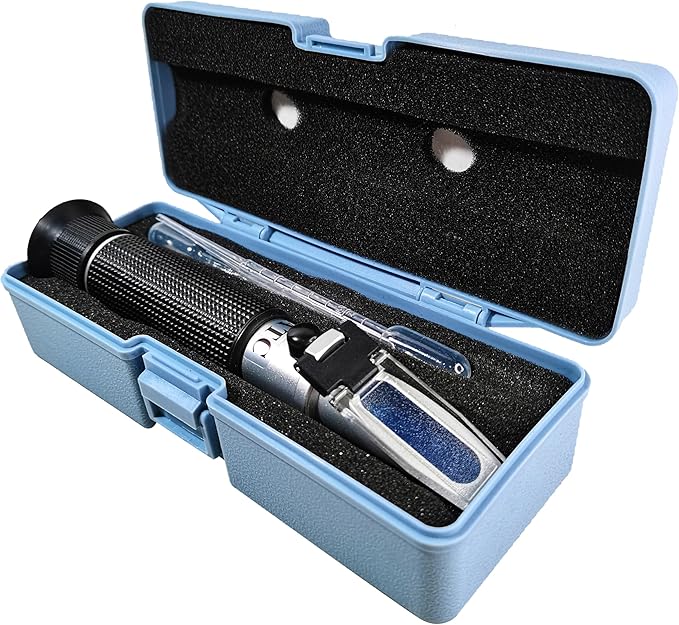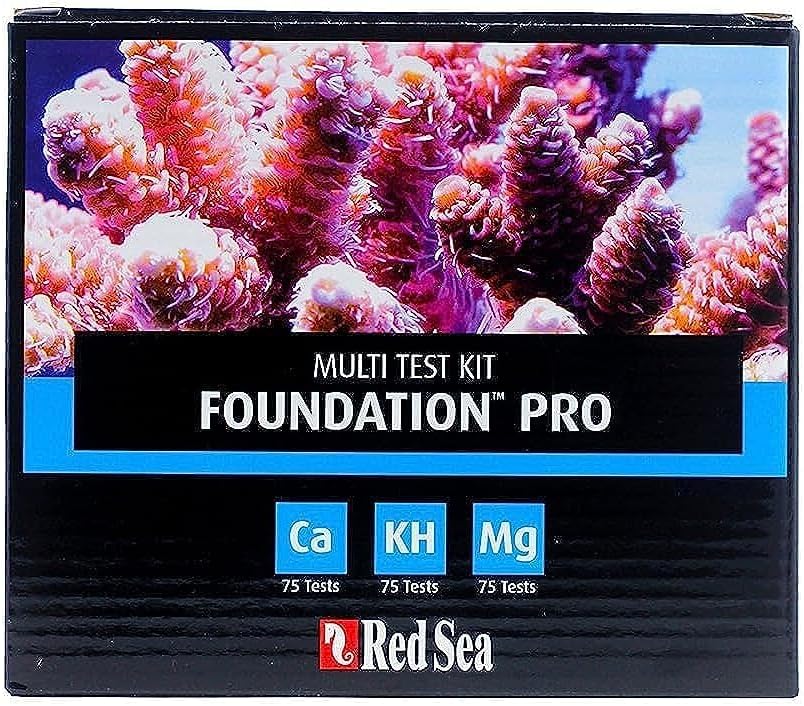Disclaimer: This page contains advertisements and/or affiliate links. We receive compensation from clicks and/or purchases made through these links. Though we may not have tested the specific product(s) mentioned, we do our best to recommend products that are beneficial to our visitors.
Best Water Parameters for Reef Tanks
Last updated on October 11th, 2024

What are the best water parameters for a reef tank?
This article will focus on finding the ideal parameters for any reef aquarium, focusing not only on the value itself, but also thinking about the swing that is considered acceptable for these parameters. Though much of this, especially Alkalinity, Calcium, and Magnesium apply only to reef aquariums, applying the other parameter values to a fish only tank will help to keep your aquarium happy and healthy.
Best Temperature for Reef Tanks
There are a lot of opinions about the "best" temperature for reef aquariums. There have been studies showing different coral and fish living in environments as low as 60 degrees all the way up to 95 degrees. Even though, we can see this behavior in nature, it is uncommon to keep a home aquarium successfully at either of these extremes. This is because most coral or fish from the high and low ends of this range will likely not thrive in the opposite end of the range. In order to best keep a wide variety of fish and coral, we generally lean near the middle point.
When it comes to reef aquarium temperature, the commonly accepted range is roughly 77-80 degrees Fahrenheit. If you live in a colder climate, like the Midwestern States (i.e. Wisconsin, like me) you may want to choose the higher end of this range to help offset the cold. In warm climates you may want to try and maintain the lower end of the acceptable range.
Though this range of 77-80 degrees Fahrenheit is considered acceptable, if you stray from this a little, most reef
inhabitants will adapt as long as the changes are made slowly. Despite this range where coral, fish, and
invertebrates may adapt, reef aquariums are more sensitive to swings in temperature than the exact number itself.
When setting up temperature control for your reef aquarium, it is best to keep the temperature stable, within 1
degree Fahrenheit of the temperature you set. You can maintain this temperature control through the use of an
Learn more about Heaters and Temperature Control in the article: Saltwater Aquarium Heater Guide.
Best Salinity for Reef Tanks
1.024 to 1.025 (32 to 33 ppt)
The second most important reef tank parameter is salinity. The best salinity range for a reef aquarium is 1.024-1.025, or 32-33 ppt. The key methods to maintaining this salinity level are to make sure to mix salt water to the correct levels before a water change, and to utilize an Auto Top Off (ATO) which adds fresh water back to the aquarium as the water evaporates.
While you don't need to measure salinity frequently, I strongly encourage using a reliable method of measurement.
Personally, I use the Hanna Salinity Checker to get consistent measurements. A good
Learn more about Auto Top offs in the article: Saltwater Aquarium ATO Guide.
Best Reef Tank Alkalinity
Alkalinity, the first of the big three coral growth parameters, has an accepted range between 8-12 dKh. This value should be maintained within 0.5 dKh of the desired value. Some coral can be especially sensitive to large changes over a day's time and therefore alkalinity needs to be maintained quite tightly. Ideally, you will want to dose alkalinity buffer supplements using a Dosing pump.
When measuring alkalinity, it's important to check the value at the same time every day. The aquarium's pH can
affect the alkalinity. Meaning the time of the lighting cycle, and even if windows are open or closed, can affect
this reading. So it's best to test daily and at the same time for the most consistent result. Personally, I'm a
fan of the Hanna Alkalinity Checker, but manual titration tests like the
Learn more about Alkalinity, Calcium, and Magnesium (The Big Three) in the article: Understanding and Balancing Alkalinity, Calcium, and Magnesium in Reef Aquariums.
Best Reef Aquarium Calcium
400-450 ppm
The ideal range for Calcium in reef aquariums is from 400-450 ppm. As the second of the "Big Three" parameters for coralgrowth, you should monitor this closely, but not with as much exactness as alkalinity. As long as the calcium needed by the coral is present, the coral will generally be happy. The key is that calcium and alkalinity go hand in hand and need to remain balanced. Therefore, you should use an Automatic Dosing pump to keep these values dosed equally.
When testing calcium, I find that the Hanna checker is not quite as consistent, so I like to use a titration test kit like the Red Sea Reef Foundation Test Kit.
Learn more about Alkalinity, Calcium, and Magnesium (The Big Three) in the article: Understanding and Balancing Alkalinity, Calcium, and Magnesium in Reef Aquariums.
Best Reef Aquarium Magnesium
1250-1400 ppm
Magnesium, the final of the "Big Three", has an acceptable range between 1250-1400 ppm. Though not as critical as alkalinity and calcium, magnesium plays an important role in coral growth. Magnesium is the parameter that helps coral absorb the alkalinity and calcium needed to grow. It also acts as a buffer between carbonate and calcium ions, preventing them from precipitating. So for higher alkalinity levels, you would want to be higher in magnesium as well.
Learn more about Alkalinity, Calcium, and Magnesium (The Big Three) in the article: Understanding and Balancing Alkalinity, Calcium, and Magnesium in Reef Aquariums.
Best Reef Aquarium Nitrates
1-10ppm (10x or 100x Phosphates)
Until recently, nitrates had always been idea to maintain as low as possible. Recent studies are finding that coral grow and color up better with the presence of a small amount of nitrate available. There is very little benefit to extremely low nitrates. Since nitrates often come from food and overfeeding, it can be difficult to maintain the ideal range of 1 - 10ppm. Many of us, myself included, tend to be above this range. The two schools of thought seem to be either 10x phosphate or 100x phosphate. There really hasn't been an exact number decided. But high phosphates tend to lead to algae problems. So I would lean toward 100x phosphate and keeping phosphate low.
Best Reef Aquarium Phosphates
0.1x Nitrate or 0.01x Nitrate
Similar to nitrates, phosphates are usually kept low in reef tanks. SPS corals, such as acropora, have been found to have better growth and coloration when there is some amount of phosphate available within the aquarium. The accepted amount of phosphates can be found using the Redfield Ratio. The Redfield Ratio is the ratio of nitrates to phosphates found within the ocean. Though this ratio is ideally utilized for algae growth, it will also provide a familiar nitrate to phosphate level that the coral are adapted to.
The Redfield Ratio indicates that the molar ratio of Nitrate to Phosphate should be 16:1. However, the molar ratio is not what we measure. We measure ppm. If you want to see the math, you can see it here. However, the result is 1/10th of the nitrate.
Just like Nitrate though, there is an argument that lower phosphate is better since it can hinder coral skeleton growth. So keeping phosphates at 1/100th of nitrate may be better.
Best Reef Aquarium Ammonia and Nitrite
For good measure, and completeness sake, I wanted to mention Ammonia and Nitrites. These parameters should ALWAYS be kept at 0. These parameters are toxic to all aquarium life and can quickly kill off an entire tank. Ensure your aquarium is properly cycled before adding life and be patient and add life slowly in order to prevent spikes in these parameters.
Learn more about the Nitrogen Cycle in the article: How to Cycle a Saltwater Fish Tank.
Minor and Trace Elements
Though these are not often measured, and should be the last of your concerns when determining the ideal values for a reef aquarium, I felt like I should comment on these to have a complete resource for you, the readers. Below are the target values for the following trace and minor elements. Please note, you should not try to worry about these values until you are working with a stable reef aquarium for at least a year and know what you are adding, as many supplements have added phosphates and though large amounts of these parameters may not have a major negative effect, the added phosphates may.
- Potassium - 0.3953g/kg
- Bromide --- 0.0663g/kg
- Boron ----- 0.0044g/kg
- Strontium - 0.0079g/kg
- Fluoride -- 0.0013g/kg
Conclusion
Hopefully these ranges help you with maintaining your ideal reef tank parameter levels. There will always be debate over what is best. With a lot of research, I find that these are the values often used by successful reef tanks. I'm not saying they're the only values that work however. But this should set you well on your way for an ideal reef tank.
About the Author
John Krenzer

John is a Software Engineer with a passion for saltwater aquariums, as well as the founder and president of Reef Stable. He started in the aquarium hobby as a child with a 20 gallon freshwater aquarium. His interest in aquarium life grew and in 2008, John set up his first saltwater aquarium.
Today, John maintains an over 300 gallon reef tank system, consisting of a 120g reef and a 210g reef. These large tanks are contained within the same system, sharing a sump as a means to reduce total maintenance and increase total water volume.
John writes articles for the blog as a means to learn about more reef aquarium topics. These articles act as a reference for the readers as well as himself. John updates these articles frequently to provide additional information or make corrections as new information becomes available.
If you would like to request an article, tank tour article, or to collaborate, let me know via the






















Social Media